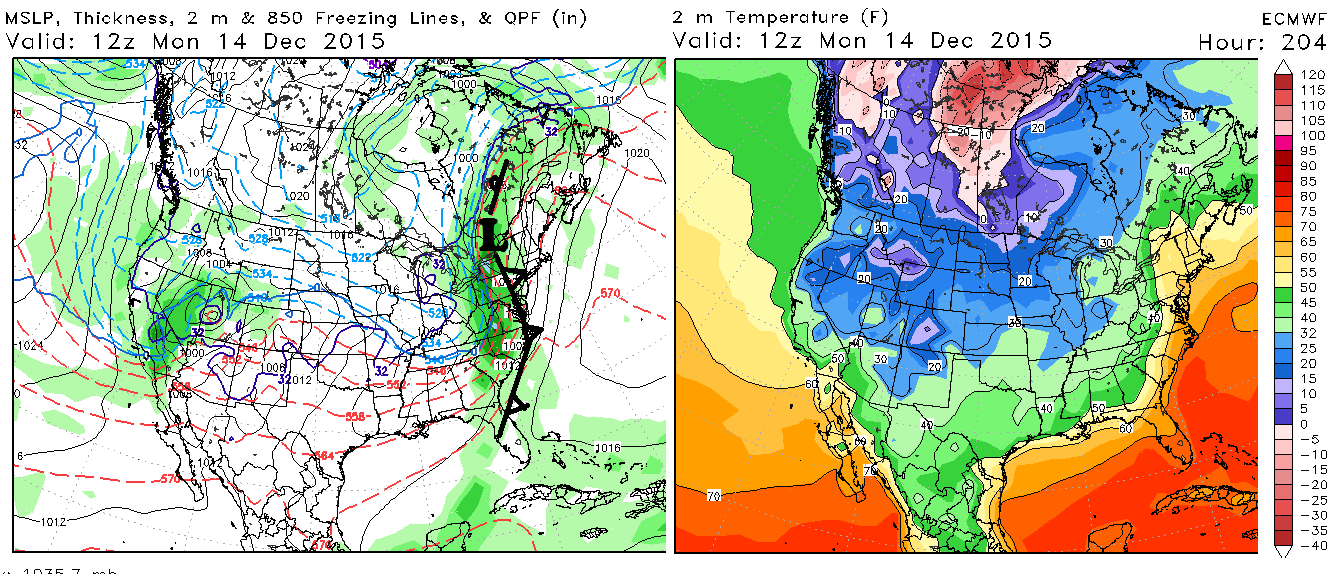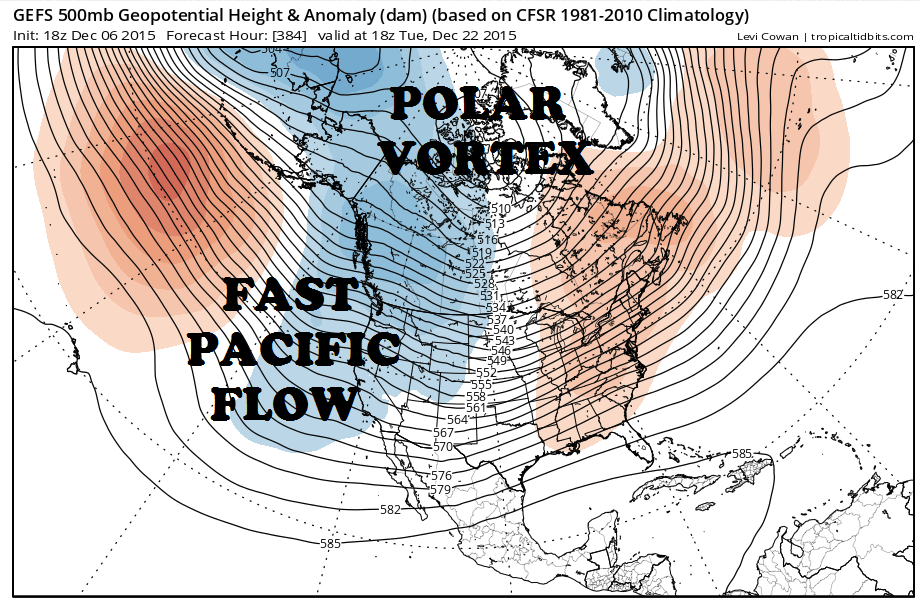It’s been another brown week here in ilsnow land. I don’t see any real change coming for a while.
So, I will give you a thumbnail sketch of what is going to happen for the remainder of December and more important: What needs to happen for winter to FINALLY make a show of force around here.
Arctic Oscillation/North Atlantic Oscillation:
Most weather nerds know that negative AO and NAO help us in regards to getting cold and snowy weather around here in the winter.
Well, that’s not happening yet. Both have been running in positive territory since mid-October:


Yeah, some of the GFS ensembles show the Arctic Oscillation plunging to negative, which I believe is a steaming pile of crap because the pattern is highly locked into the positive phase right now. Even if it does tank to slightly negative, that change would be very short lived.
There will be many times in the next several weeks, calling for “massive pattern changes” that will never happen because they see arctic blasts manufactured by the operational GFS model, which has a dubious track record as a lousy forecasting tool.
West Pacific Oscillation (WPO)
Oh boy, yet another oscillation! The WPO has been locked in its positive phase since mid-October and looks to remain this way for probably the remainder of December:

Why does this really suck for us? Simply stated, the strong pressure gradient between the Bering Sea Low and Central Pacific High sends a screaming, howling Pacific jet into the United States in this configuration. When that happens, much of North America is flooded with mild air. Look at the surface temperature departures (SFCT) over Canada into the Great Lakes region:

There is no way to get sustained cold from that kind of a set up, especially when you pair that up with positive AO/NAO.
What’s happening next?
In the short to mid term, more of the same!
GEFS ensembles are showing amazing warmth over eastern North America, especially between the 11th and 16th:

The “highlight” of this will be a warm wave around December 14th in which temperatures may be well into the 50s to start the day:

The good news? There won’t be a meltdown, only because there will be nothing to lose! Since the Arctic air is locked up north, I don’t expect much of a lake-effect snow response after the cold frontal passage mid-month.
Pattern change to end December?
With each passing day, December appears to be a lost cause. We’re almost half way through December and can see the general picture for the rest of the month.
The GEFS ensemble through December 22nd is showing the Polar Vortex still marooned north of the Arctic Circle and the fast Pacific jet slamming into North America:

This would not be a cold pattern by any stretch of the imagination. We’ve seen what this does before and we know what this will do again: keep the cold away from us!
I’ve heard rumbling of the “massive pattern switch” happening before the end of the year. Let’s take a look:

Between Christmas and New Year, the Polar Vortex is still stuck up north. But we do have some troughing and cooler temperatures in the eastern United States. If we get lucky, a snow event could emerge out of this. But needing to get lucky is NOT a pattern change.
The last week of December is likely to be better in terms of snow and cold than the rest of the month, but is that really saying much? That would be like saying the Philadelphia 76ers will close out December better than they started. Not exactly awe inspiring given where the 76ers are right now.
Going ahead?
Our snowfall for October-November-December (OND) is running far below normal. As of December 10th, it’s an incredibly low 2.4 inches.
For fun, I compared our snow-less start to the 5 slowest starts in the past 20 years and the subsequent snow season totals for Indian Lake. At first, my cutoff was 20 inches for OND. But the notoriously crappy winters of 2001-02 and 2011-12 were just outside of my arbitrary cut-off of 20 inches, so I felt compelled to add them.
The results were pretty interesting:

The average of the 7 winters (96.4″) was below normal, but there was great variability and some winters that had strong back half snowfall.
Keep in mind these should not be taken as “analogue” winters but this does show that we can bounce back from very poor starts, if there are dominoes in place for the changes to happen.
Winters like 2001-02 and 2011-12 were “lost causes” with low autumn Siberian snow pack and cold PDO-. They never really had a chance.
Other winters like 2006-07 and 2010-11 had decent autumn Siberian snow pack and needed some time to blossom into solid snow seasons.
The million dollar question: Do we have dominoes in place that can turn this winter around?
I believe we do.
Weakening El Niño
There is no doubt that El Niño is leaving its stamp on autumn and early winter. But El Niño is starting to level off or decline in all ENSO regions:

Furthermore, the CFSv2 ensembles continue to show steady weakening of El Niño as we progress through the winter:

If El Niño has truly peaked, this would give us hope for the second half of the winter, meaning mid/late January through February and perhaps into March. The notorious super-Niños of 1982-83 and 1997-98 peaked in February and kept it relatively mild all winter.
A secondary effect of a weakening Niño may be a relaxation of the strong WPO+ and associated Pacific jet.
Caveat: If El Niño enjoys a resurgence later this winter, we could be seriously screwed.
Weakening Polar Vortex
The stratospheric Polar Vortex is very strong right now, reflected by the positive Arctic Oscillation. This has kept the Arctic cold locked away from us.
In theory, the strong autumn surge in Siberian snow pack increases the transfer of heat energy from the troposphere to the stratosphere from December into early January and weakens the stratospheric Polar Vortex, resulting in a shift to the negative phase of the Arctic Oscillation for the heart of winter:

There is a strong link between the spread of Siberian snow cover in October and the severity of cold we experience in the heart of winter. This year, it ranked #6 out of the past 48 years. I believe that means something, especially if El Niño starts to fall off a cliff this winter.
Caveat: If the stratospheric Polar Vortex doesn’t weaken, we’re screwed!
Warm PDO+
PDO+ is signified by anomalously warm water in the northeast Pacific and it’s strongly linked to cold winters in the eastern United States. You can read what the warm PDO+ can do here, especially deep into the winter.
The waters in the northeast Pacific have cooled somewhat in recent weeks, but it has cooled off even faster in the northwest Pacific. This maintains a strong PDO+ signature going into the winter:

Caveat: The warm PDO+ is the safest bet in the house, but if El Niño and the stratospheric Polar Vortex don’t weaken appreciably within the next 3-4 weeks, it may not matter.
Bottom line?
Unlike 2001-02 and 2011-12, we have dominoes that could fall in place for a major pattern reversal. But the groundwork needs to be laid out over the next month or so and that’s what we’ll need to watch.
I wasn’t expecting much of winter until the New Year. But to watch the autumn and early winter (meteorological winter started December 1st) unfold has been a bit unnerving. We may need a reversal like 2006-07 to make this winter click.
We’ll see what happens. As for now, my snowmobile is safely asleep in the garage.
It’s gonna be a bumpy ride but there is hope!
For the ilsnow nation,
Darrin

